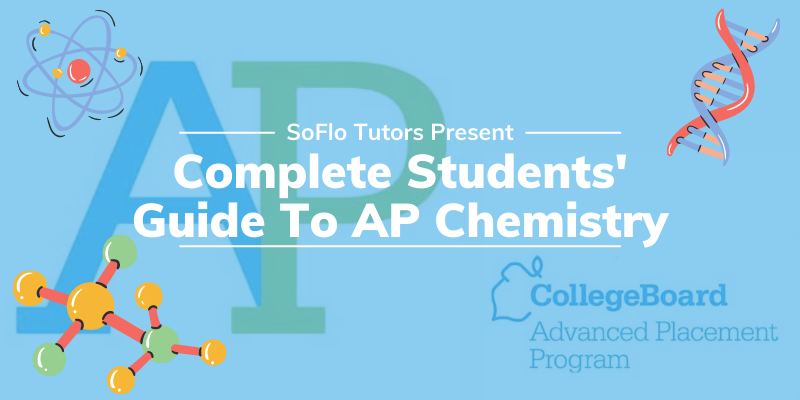
A Complete Guide To The AP Chemistry Exam
The AP Chemistry provides students with a foundation similar to that of an introductory level college chemistry course. Oftentimes, it’s taken junior or senior year of high school, after a year of general or honors chem has already been completed. The AP Chem exam is certainly undertaking, and a good understanding of what the test entails is necessary in order to succeed.
Overview of the AP Chemistry Test
The AP Chem exam runs similarly to many of the other AP exams. If you’ve ever taken an AP Exam before, the structure should be familiar to you.
How Long Is The AP Chem Test?
The AP Chemistry Exam runs as one of the longest AP exams at 3 hours and 15 minutes. However, this is just the amount of time that will be used to actually answer questions and respond to the material. Including preparation time, breaks, and other potential interludes, expect the AP Chem Exam to last around 4 hours from start to finish.
How Is The AP Chemistry Exam Scored?
Like all other AP exams, the AP Chemistry exam is scored on a scale of 1-5, where 1 represents “No Recommendation” or a failing score, and a 5 represents “Extremely well qualified” or an A+ or A college course grade equivalent. Generally, anywhere from a 3-5 is considered a passing score, although some colleges and universities may be particular and only accept 4s and 5s for credit.
It is also curved similar to other AP exams. In the case of AP chem, you will need to get roughly 75% of the questions correct to score a 5.
What Is The AP Chemistry Score Distribution?
It’s very challenging to do well on the AP Chemistry Exam. When considering the score distribution (aka the percentage of people who receive each score), only 11.2% of all students receive a 5. 16.4% of students receive a 4, 23.7% of students receive a 3, 24.7% of students receive a 2, and 23.9% of students receive a 1.
In other words, only a little over half of all students (51.3%) receive a passing score.
What’s The Structure Of The Exam?
The AP Chemistry Exam, like many of the other AP exams, is composed of two sections. The multiple choice section and the free response section.
- The multiple choice section is 1 hour and 30 minutes long, 60 questions with 4 choices each, and is worth 50% of your total score. You will not be allowed a calculator for this portion of the exam.
- The free response section is 1 hour and 45 minutes long, 7 questions total (divided into 3 long essay questions worth 10 points each and 4 short answer questions worth 4 points each), and is worth 50% of your total score. You will be allowed a four-function, scientific, or graphing calculator for this portion of the exam.
Topics Covered On The AP Chemistry Exam
There are 9 units in the AP Chemistry course that will be tested on the exam. By the end of your class, you should be familiar with the material covered and answering questions in all of the units. Some units may show up more frequently on the exam. For instance, Unit 3 – Intermolecular Forces and Unit 8 – Acids and Bases are especially popular.
| Unit | Exam Weighting |
| Unit 1: Atomic Structure and Properties | 7-9% |
| Unit 2: Molecular and Ionic Compound Structure and Properties | 7-9% |
| Unit 3: Intermolecular Forces and Properties | 18-22% |
| Unit 4: Chemical Reactions | 7-9% |
| Unit 5: Kinetics | 7-9% |
| Unit 6: Thermodynamics | 7-9% |
| Unit 7: Equilibrium | 7-9% |
| Unit 8: Acids and Bases | 11-15% |
| Unit 9: Applications of Thermodynamics | 7-9% |
Before sitting for the exam, review the list of units and topics below and make sure that you are familiar with each of the items listed.
- Atomic Structure and Properties
- Moles and Molar Mass
- Mass Spectroscopy of Elements
- Elemental Composition of Pure Substances
- Composition of Mixtures
- Atomic Structure and Electron Configuration
- Photoelectron Spectroscopy
- Periodic Trends
- Valence Electrons and Ionic Compounds
- Molecular and Ionic Compound Structure and Properties
- Types of Chemical Bonds
- Intramolecular Force and Potential Energy
- Structure of Ionic Solids
- Structure of Metals and Alloys
- Lewis Diagrams
- Resonance and Formal Charge
- VSEPR and Bond Hybridization
- Intermolecular Forces and Properties
- Intermolecular Forces
- Properties of Solids
- Solids, Liquids, and Gases
- Ideal Gas Law
- Kinetic Molecular Theory
- Deviation from Ideal Gas Law
- Solutions and Mixtures
- Representations of Solutions
- Separation of Solutions and Mixtures Chromatography
- Solubility
- Spectroscopy and the Electromagnetic Spectrum
- Photoelectric Effect
- Beer-Lambert Law
- Chemical Reactions
- Photoelectric Effect
- Introduction for Reactions
- Net Ionic Equations
- Representations of Reactions
- Physical and Chemical Changes
- Stoichiometry
- Introduction to Titration
- Types of Chemical Reactions
- Introduction to Acid-Base Reactions
- Oxidation-Reduction (Redox) Reactions
- Kinetics
- Reaction Rates
- Introduction to Rate Law
- Concentration Changes Over Time
- Elementary Reactions
- Collision Model
- Reaction Energy Profile
- Introduction to Reaction Mechanisms
- Reaction Mechanism and Rate Law
- Steady-State Approximation
- Multistep Reaction Energy Profile
- Catalysis
- Thermodynamics
- Endothermic and Exothermic Processes 6 ENE 6.2 Energy Diagrams 3 ENE 6.3 Heat Transfer and 6 Thermal Equilibrium ENE 6.4 Heat Capacity and Calorimetry 2 ENE 6.5 Energy of Phase Changes 1 ENE 6.6 Introduction to Enthalpy of Reaction 4 ENE 6.7 Bond Enthalpies 5 ENE 6.8 Enthalpy of Formation 5 ENE 6.9 Hess’s Law
- Equilibrium
- Introduction to 6 Equilibrium
- Direction of Reversible Reactions
- Reaction Quotient and Equilibrium Constant
- Calculating the Equilibrium Constant
- Magnitude of the Equilibrium Constant
- Properties of the Equilibrium Constant
- Calculating Equilibrium Concentrations
- Representations of Equilibrium
- Introduction to Le Châtelier’s Principle
- Reaction Quotient and Le Châtelier’s Principle
- Introduction to Solubility Equilibria
- Common-Ion Effect
- pH and Solubility
- Free Energy of Dissolution
- Acids and Bases
- Introduction to Acids and Bases
- pH and pOH of Strong Acids and Bases
- Weak Acid and Base Equilibria
- Acid-Base Reactions and Buffers
- Acid-Base Titrations
- Molecular Structure of Acids and Bases
- pH and pKa
- Properties of Buffers
- Henderson-Hasselbalch Equation
- Buffer Capacity
- Applications of Thermodynamics
- Introduction to Entropy
- Absolute Entropy and Entropy Change
- Gibbs Free Energy and Thermodynamic Favorability
- Thermodynamic and Kinetic Control
- Free Energy and Equilibrium
- Coupled Reactions
- Galvanic (Voltaic) and Electrolytic Cells
- Cell Potential and Free Energy
- Cell Potential Under Nonstandard Conditions
- Electrolysis and Faraday’s Law
Studying For The AP Chem Exam
Studying for the AP Chem exam can seem overwhelming, especially when there is so much content that needs to be reviewed.
Begin By Taking A Full Length Practice Exam
Taking a practice exam from start to finish will help you better understand the timing and pacing of the exam. It will also offer a realistic problem distribution, and make you better aware of what you know, don’t know, and need to study moving forward.
Try To Understand, Not Just Memorize Material
There will be a formula sheet given to you on the AP Chem exam. While memorizing basic formulas and steps to solve commonly seen problems is important, understanding the concepts behind the formulas and problems is doubly so. Understanding the units and knowing why things work the way that they do will allow you to apply your problem solving skills beyond just the most basic questions and gives you the opportunity to justify your answers.
Don’t Be Afraid To Do Some Estimation!
You won’t be given a calculator on the multiple choice section of the exam, so get really comfortable with rounding and doing calculations with large numbers to get logical answers. It’s easy to want to get the best, most accurate answer, but in this section, to save time and avoid computational error, it’s sometimes easier to round.
Practice With Official AP Chemistry Material
The College Board Website and AP Central have some really great official resources that you can use to practice for the exam. Currently, the 2021 AP Chemistry Free-Response Questions are available to download. Generally, the more recent the material, the more reflective it will be of the questions you will see on testing day.
If your teacher uses AP Classroom, ask them to release the questions that they have not yet released prior to test day, so that you have a full multiple choice and free response question bank to work through at your leisure.
AP Daily videos are also available. These videos are short lectures on every topic and skill, and provide walkthroughs of challenging problems and important review as well.
Other Tips And Tricks
The AP Chemistry Exam allows you to use a preset formula sheet as well as a periodic table when answering questions in both the multiple choice and free response sections.
Familiarize yourself with this sheet and make sure you know what each of the formulas are, when to use them, and where they are on the sheet, so when time comes, you aren’t going back and forth spending valuable time doing last minute interpretation or trying to find the formulas on the page.
Be specific! In this exam, as well as many other science exams, you will be working with a ton of different units, symbols, definitions. Make sure you’re using the correct, most specific terminology possible in order to avoid confusion or vagueness.
Demonstrate to your AP grader that you know exactly what you’re talking about. For example, if you’re talking about an atom, refer to it as such, and not as a molecule or an ion or a particle- that would be incorrect.
As with all major exams, create a study calendar for yourself and don’t try to cram all the material in the week (or even the night) before. Going through each unit methodically and allowing yourself time to truly synthesize and understand the material and do adequate practice questions is the best way to prepare.
Get a good night of sleep before the exam. Going into an exam sleep deprived is never productive, and while you may have been up late trying to do some last minute review, this type of practice will only hurt you in the long run.
College Board also offers a more comprehensive list of AP Chemistry Exam Tips. I would encourage you to look through this list and make sure you’re doing exactly as they say. As the governing body for the AP Chemistry Exam, following their advice on what to do ensures that you provide the best, most accurate responses.
The next AP Chem exam is scheduled for Monday, May 2, 2022 at 12 pm local time. Best of luck to anyone taking this exam!
Prepare For Your APs With SoFlo
If you’re stressed about your upcoming AP Chemistry exam, or are looking for some help while going through the course, SoFlo is a great resource to get you started. SoFlo offers one-on-one tutoring for every AP exam, and there is guaranteed to be a tutor with the expertise to help you excel. SoFlo students make their own schedules and are offered flexible tutoring plans while also seeing noticeable improvements in their scores.
Schedule a free consultation now!
Sources:
About the Author
Originally from Princeton, New Jersey, Shirley Xie attends Johns Hopkins University and is majoring in Public Health and Behavioral Biology. She scored a 1580 on the SAT. In her free time, she enjoys playing volleyball and baking with friends.









